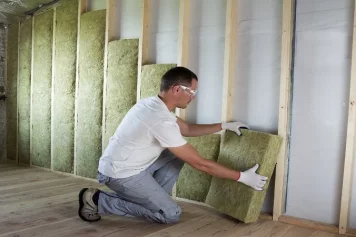The DPE, or energy performance diagnosis, has become essential in the French real estate sector. This document assesses a home’s energy consumption. It also analyzes greenhouse gas emissions.
The DPE (Energy Performance Certificate) comes in the form of labels from A to G. These labels indicate the building’s energy performance level. They directly influence the property’s value. A well-rated home attracts more potential buyers. It also generates significant savings on energy bills.
Regulations require this diagnostic for all property sales and rentals. The DPE informs future occupants about the energy quality of the home. It has become a decisive criterion in real estate choices. Housing classified as F or G is considered “thermal sieves.”
Energy renovation work can improve this classification. Insulation, heating, and domestic hot water production are essential. These improvements reduce excessive energy consumption in buildings.
Reno, a renovation company in Paris, supports homeowners in this process. Our expertise in home construction and renovation guarantees optimal results. We offer solutions tailored to the requirements of the French Building Code.
The DPE is now valid for ten years. The calculation method has evolved to provide greater accuracy. The recommendations included in the diagnosis guide homeowners toward effective improvements. This advice is invaluable for planning relevant energy renovation work.
Understanding the DPE: definition and importance in real estate
The energy performance diagnosis assesses the thermal efficiency of a home. It measures the annual energy consumption. This document helps buyers and tenants make informed choices.
The DPE (Energy Performance Certificate) has become mandatory for all property sales and rentals in France. This diagnostic has been required by law since 2006. Owners must present this document during real estate transactions.
The legal framework for the DPE is based on the Construction and Housing Code. These regulations aim to improve the energy performance of buildings. They also encourage the reduction of greenhouse gas emissions.
The DPE and its impact on real estate value
Energy efficiency ratings directly influence the price of a property. A well-rated property attracts more potential buyers. It can sell for up to 15% more than a thermal sieve.
The importance of the DPE in purchasing decisions increases every year. Buyers carefully examine this information before signing. They anticipate the energy renovation costs associated with a poorly rated home.
The link between energy class and attractiveness is becoming evident. Housing classified as A or B sells more quickly. Housing classified as F or G suffers significant market discounts.
How the energy performance diagnosis works
The DPE calculation method analyzes several technical parameters. It evaluates insulation, heating, and domestic hot water production. These factors determine the energy performance of the home.
Professionals perform the DPE according to strict procedures. They inspect the walls, windows, roof, and heating systems. Then they use certified software to calculate the results.
The parameters taken into account also include the building’s orientation. Ventilation and airtightness are also important. These factors affect the annual amount of energy consumed.
The information contained in an EPC
The energy label classifies housing from A to G based on its energy consumption. The climate label indicates the level of greenhouse gas emissions. These two scales allow for a comprehensive assessment.
The work recommendations are clearly outlined in the document. They suggest improvements to reduce excessive energy consumption. These tips help prioritize the most effective renovation projects .
Consumption information includes precise figures. It details the estimated cost of annual energy expenditures. These forecasts help budget for future housing expenses.

Energy classes of the DPE and their meanings
Energy classes range from A (very efficient) to G (very energy-intensive). Class A corresponds to less than 70 kWh/m²/year of consumption. Class G exceeds 420 kWh/m²/year of consumption.
Consumption thresholds precisely define each category. A difference of one class can represent up to 100 kWh/m²/year. This difference significantly impacts occupants’ energy bills.
The impact of housing classes on the real estate market is becoming crucial. Since 2023, certain G-class properties have been prohibited from renting. This restriction will gradually extend to classes F and then E.
The impact of the DPE on the real estate market
The real estate market is undergoing a transformation linked to energy performance diagnostics. Buyers are now carefully examining this technical information. This attention is changing behaviors during real estate transactions.
The price of properties varies considerably depending on their energy rating. A or B-rated housing attracts more buyers. Its price per square meter often exceeds that of energy-intensive properties.
Homeowners are now anticipating these new energy requirements. They are carrying out renovations before putting them up for sale. This strategy maximizes the value of their real estate assets.
The consequences of the DPE on real estate prices
Energy performance directly influences the value of real estate. Studies show a significant price gap. Energy-efficient homes sell for up to 15% more.
The market clearly distinguishes between different energy classifications. This distinction creates a hierarchy of real estate prices. Properties classified as F or G suffer a significant discount.
Real estate appraisals now systematically include the energy factor. Professionals calculate this parameter precisely. They sometimes recommend improvements before the sale.
Analysis of price gaps according to energy labels
Class A housing enjoys strong commercial appeal. Their rarity reinforces their market value. These properties represent less than 3% of the French real estate market.
Class B also offers a significant commercial advantage. These homes consume little energy on a daily basis. The savings justify their higher price.
Properties classified C and D represent the current market average. They meet recent construction standards. Their prices remain stable despite regulatory changes.
Financial impact of thermal strainers on investment
Thermal strainers are rapidly losing their market value. This depreciation is accentuated by new regulations. Investors are now avoiding these problematic assets.
Profitability calculations now include renovation costs. Accurate diagnostics make it possible to estimate these expenses. The energy audit is becoming an essential financial assessment tool.
Renting thermal colanders is gradually becoming impossible. This ban is transforming the French rental market. Owners are forced to renovate or sell.
The evolution of buyers’ search criteria
Buyers are primarily looking for energy-efficient homes. This preference is changing the strategies of real estate agencies. Advertisements are emphasizing energy performance.
Energy consumption is becoming a determining factor for many. Buyers are calculating the overall cost, including utilities. They are prioritizing properties that offer optimal thermal comfort.
Greenhouse gas emissions are also a concern for buyers. This environmental sensitivity influences purchasing decisions. Eco-friendly goods enjoy a clear marketing advantage.
The importance of the DPE in real estate advertisements
Displaying the DPE is mandatory in all real estate listings. This requirement enhances market transparency. Consumers can easily compare energy performance.
Real estate portals offer specific filters for energy performance ratings. This feature facilitates targeted searches. Energy-efficient properties thus gain commercial visibility.
Photographs of energy labels are routinely displayed. This visual presentation impacts first impressions. Poor rankings often deter potential visitors.
The influence of the DPE on sales times
Well-rated homes generally sell faster. This fluidity benefits owners and real estate agents. Marketing time is significantly reduced.
Properties rated F or G sometimes stagnate for several months. This slowness discourages some sellers in a hurry. They often have to lower their prices to attract buyers.
The real estate market is therefore clearly segmented by energy efficiency. This segmentation is transforming business strategies. Professionals are adapting their communications accordingly.
Real estate enhancement strategies through energy renovation
Energy renovation is a powerful lever for increasing value. Owners increase the value of their property while simultaneously improving its commercial appeal.
Targeted work often offers the best return on investment. Attic insulation provides immediate results. Window replacement also improves energy efficiency.
Modern heating systems transform the performance of homes. These installations significantly reduce energy consumption. They also improve occupant comfort.
The most efficient technical solutions
External thermal insulation radically changes energy performance. This technique preserves the interior living space and effectively eliminates thermal bridges in the building.
Heat pumps represent a high-performance solution. These devices are a great replacement for older boilers. Their installation generally improves the DPE rating by one class.
Dual-flow ventilation optimizes indoor air quality. It recovers heat from the extracted air. This system significantly reduces heating requirements.
Calculating the return on investment for energy works
Owners now analyze the return on investment. This assessment compares costs with expected benefits. It includes energy savings and property appreciation.
Well-planned work generally pays for itself within a few years. This period varies depending on the characteristics of the property. A preliminary audit helps identify priority interventions.
The market particularly values comprehensive and coherent renovations. These transformations significantly improve energy efficiency. They also optimize thermal comfort year-round.
The DPE as a negotiation tool during transactions
The diagnostic is often used as a selling point during real estate negotiations. Buyers demand discounts for energy-intensive properties. These requests reflect future energy costs.
Sellers of well-rated homes firmly maintain their prices. They have a real competitive advantage in the market. Their sales pitch emphasizes these energy advantages.
Real estate agents use the DPE to properly position properties. This strategy maximizes the chances of closing quickly. It also avoids disappointment during viewings.
Negotiation techniques related to energy performance
Buyers accurately calculate the cost of necessary renovations. This assessment supports their requests for a discount. They often submit multiple quotes to justify their position.
Owners sometimes prepare specific technical counterarguments. They highlight the specific qualities of their property. They also present accessible improvement solutions.
Real estate professionals now advise both parties. They explain the practical implications of energy classification. Their expertise helps reach a fair agreement.

Who can carry out an EPC and how is the diagnosis carried out?
Only a certified diagnostician can perform a valid DPE. They have a specific certification recognized by the state. This qualification guarantees the reliability of the DPEs performed.
The professional uses specialized measuring tools. He collects all the technical information about the property. Then, he applies the applicable methods and procedures in accordance with regulations.
The DPE’s validity period has now reached ten years. This period may seem long, but it remains justified. A building’s energy characteristics evolve slowly without any work.
The cost and timeframe for obtaining an energy performance diagnosis
The price of an EPC varies depending on several important factors. The size of the home directly influences the cost. A larger apartment requires more time for inspection.
Prices generally range between €100 and €250. There are differences depending on the region of France. Consider requesting several quotes to compare offers.
The average time to obtain the document remains reasonable. Most diagnosticians respond within 48 to 72 hours. The full report generally arrives one week after the visit.
How to improve the energy performance of your home?
Insulation is the top priority for energy efficiency. It limits heat loss from the building. A well-insulated home consumes significantly less energy.
The heating, cooling, and water production system plays a crucial role. Old equipment often consumes too much energy. Replacing it quickly generates substantial savings.
Reno’s solutions transform your energy-intensive home. Our renovation company designs custom projects. We focus on projects with a high energy impact.
Support from energy renovation professionals
The benefits of energy renovations in co-ownership are numerous and long-lasting. The savings offset the initial investment. The thermal comfort of occupants improves considerably.
The expertise of our interior designers guarantees optimal results. They are fully conversant with modern insulation techniques. Their recommendations comply with the Construction and Housing Code.
Customized solutions can effectively improve energy efficiency. Each home has unique characteristics. A standardized approach rarely yields the best results.
The DPE and the obligations of owners and tenants
Property owners must provide a valid DPE (Energy Performance Certificate) for all transactions. This requirement applies to the sale and rental of real estate. The document must be included in real estate listings.
Tenants can now request this assessment before signing. They have the right to know the performance of the property. This information influences their decision and the amount of rent.
The consequences for excessive energy consumption in housing are becoming serious. Properties classified as G are gradually being banned from rental. This ban will extend to classes F and then E.
The evolution of regulatory requirements
The timetable for restrictions on energy-intensive housing is accelerating. Since January 2023, Class G rentals have been banned. This measure targets homes exceeding 450 kWh/m²/year.
The future outlook for energy obligations is clear. By 2028, all F and G-rated homes will be banned. Homeowners must anticipate these changes quickly.
Reno’s assistance helps you optimize your energy bill effectively. Our renovation company offers a comprehensive energy audit. We identify priorities to comply with future regulations.
DPE: the essential points
Energy performance diagnostics are now central. They directly influence the value of real estate. Buyers and tenants are paying increasing attention to them.
The energy performance of buildings is becoming a major issue. It addresses current environmental concerns. Reducing greenhouse gas emissions is driving these developments.
Professional support is essential for renovations. Reno offers solutions tailored to each situation. Our expertise guarantees the effectiveness of the work carried out.
Homeowners benefit from anticipating future regulatory requirements. Energy-efficient homes retain their value. They also offer greater daily living comfort.
The benefits of good energy performance extend beyond financial aspects. They include a reduction in the environmental impact of housing. The quality of life of occupants is significantly improved.
The DPE is therefore much more than just a legal obligation. It becomes a valuable tool for planning for the future. Energy renovation work represents a profitable investment.
FAQ on the DPE
How long is an energy performance diagnosis valid for?
The DPE is currently valid for ten years. This period has been extended since the 2021 reform. The document remains valid even in the event of a subsequent sale or lease.
However, certain modifications to the home may invalidate the diagnosis. Major renovations require a new energy performance certificate. Installing a different heating system requires this update.
Owners retain this document for its entire validity period. A digital copy makes it easier to share with buyers. The diagnostician generally provides the document in PDF format.
Is an EPC mandatory for all types of real estate?
The DPE (Energy Performance Certificate) applies to almost all housing in France. This applies to single-family homes and apartments. Commercial buildings must also have this certificate.
There are a few rare exceptions in current legislation. Temporary buildings are exempt from this requirement. Historic monuments also benefit from specific exemptions.
Seasonal rentals of less than four months remain exempt. Accommodation intended for occupancy of less than 120 days remains exempt. However, these special cases remain very limited.
How to contest the results of a DPE ?
Disputing a DPE begins with a dialogue with the diagnostician. You can report any errors you find. They must correct any factual inaccuracies free of charge.
In the event of persistent disagreement, a second assessment becomes necessary. A second certified professional then performs a new diagnosis. This process remains the responsibility of the disputant.
Legal recourse is the last resort available. You can take the matter to court in the event of a manifest error. This procedure requires solid technical evidence.
What are the most effective works to improve the energy class of a home?
Attic thermal insulation offers the best return on investment. It reduces heat loss by up to 30%. Its cost remains reasonable compared to the savings generated.
Replacing single-glazed windows significantly improves comfort. These openings often create significant thermal bridges. Double-glazed models drastically reduce heat loss.
Installing a heat pump transforms energy performance. It advantageously replaces outdated electric heaters. Its efficiency far exceeds that of traditional systems.







